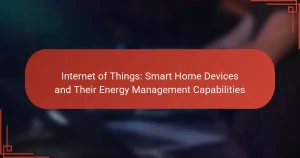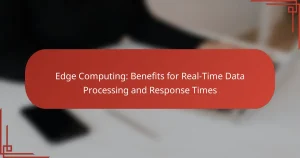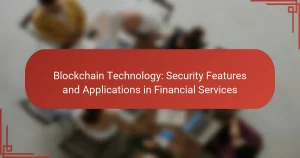5G technology represents the fifth generation of mobile networks, delivering faster data speeds, lower latency, and enhanced capacity. It operates on a higher frequency spectrum, facilitating improved connectivity for a wide range of applications, particularly in smart cities and Internet of Things (IoT) integration. With speeds reaching up to 10 Gbps and the ability to support up to 1 million devices per square kilometer, 5G enhances real-time communication and operational efficiency for smart devices. However, challenges such as infrastructure development, spectrum allocation, security concerns, interoperability issues, and regulatory hurdles must be addressed to maximize the benefits of 5G technology in these domains.
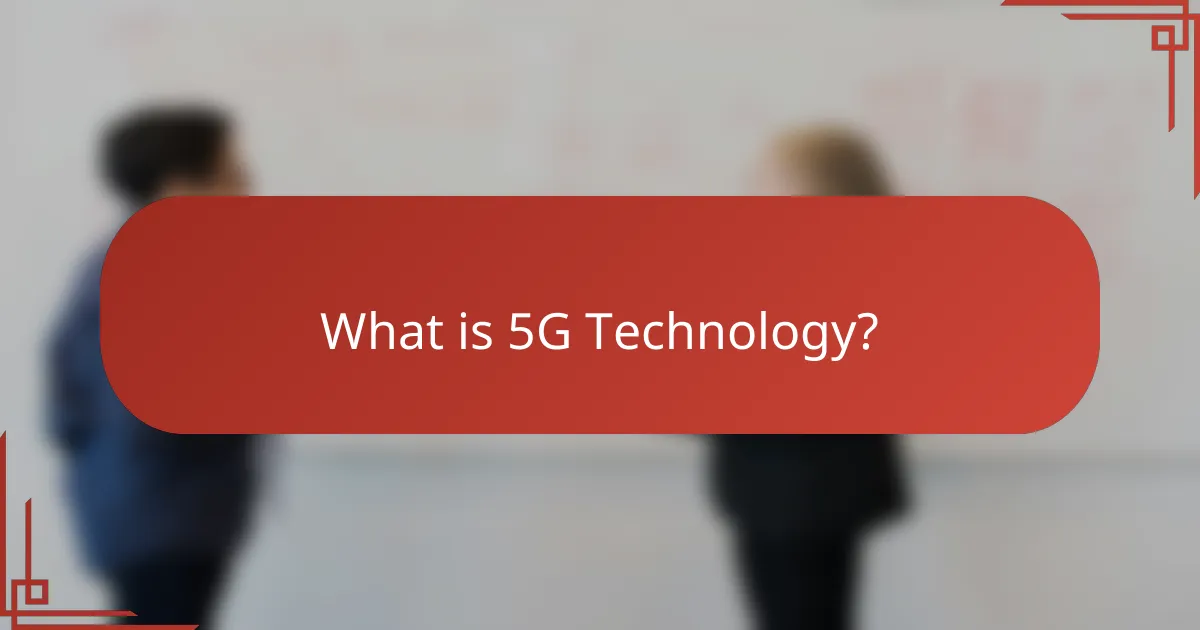
What is 5G Technology?
5G technology is the fifth generation of mobile network technology. It offers significantly faster data speeds, lower latency, and increased capacity compared to previous generations. 5G operates on a higher frequency spectrum, which allows for more data to be transmitted simultaneously. This technology supports a wide range of applications, including enhanced mobile broadband and IoT connectivity. According to the Global System for Mobile Communications (GSMA), 5G can achieve speeds up to 10 Gbps. The deployment of 5G is expected to enable advancements in smart cities and improve IoT integration.
How does 5G Technology differ from previous generations?
5G technology differs from previous generations primarily in its speed, capacity, and latency. 5G offers download speeds up to 10 Gbps, significantly faster than 4G’s maximum of 1 Gbps. It can support up to 1 million devices per square kilometer, enhancing connectivity in densely populated areas. The latency in 5G networks is as low as 1 millisecond, compared to 30-50 milliseconds in 4G. This reduction enables real-time communication for applications like autonomous vehicles and remote surgery. Additionally, 5G utilizes advanced technologies such as millimeter waves and massive MIMO, which improve network efficiency and performance. These advancements make 5G essential for smart cities and IoT integration, allowing for more responsive and interconnected systems.
What are the key features of 5G Technology?
5G technology features high-speed data transfer, low latency, and increased connectivity. It supports download speeds up to 10 Gbps. Latency can be as low as 1 millisecond. 5G connects more devices simultaneously than previous generations. It offers enhanced mobile broadband for improved user experiences. Network slicing allows for tailored connectivity solutions. 5G uses advanced technologies like MIMO and beamforming for efficiency. These features enable smart city applications and IoT integration effectively.
How does 5G Technology enhance connectivity?
5G technology enhances connectivity by providing significantly faster data transfer speeds. It can achieve speeds up to 10 Gbps, which is up to 100 times faster than 4G. This increased speed allows for seamless streaming and quicker downloads. Additionally, 5G reduces latency to as low as 1 millisecond. This minimal delay enables real-time communication for applications like autonomous vehicles and remote surgeries. Furthermore, 5G supports a greater number of devices per square kilometer, estimated at over 1 million connections. This capability is crucial for smart cities and IoT devices, which rely on constant connectivity. Overall, 5G technology transforms how devices communicate and interact in densely populated areas.
What role does 5G play in Smart Cities?
5G plays a crucial role in the development and functionality of Smart Cities. It provides high-speed connectivity essential for real-time data transmission. This enables efficient communication between devices and systems in urban environments. 5G supports a massive number of connected devices, facilitating the Internet of Things (IoT). This connectivity enhances services like smart traffic management and energy distribution. For instance, 5G can reduce latency to milliseconds, improving response times for emergency services. Studies indicate that 5G can increase data transmission speeds up to 100 times faster than 4G. This capability is vital for applications requiring instant data processing, such as autonomous vehicles. Overall, 5G is fundamental in creating responsive, efficient, and interconnected urban ecosystems.
How does 5G Technology support urban infrastructure?
5G technology supports urban infrastructure by providing high-speed connectivity and low latency. This enables real-time communication between devices, enhancing the efficiency of smart city applications. For example, 5G allows for better traffic management through connected vehicles and smart traffic signals. It also supports the deployment of IoT devices that monitor environmental conditions and optimize energy use. Furthermore, 5G networks can handle a larger number of connected devices simultaneously. This is crucial in densely populated urban areas where demand for connectivity is high. The increased bandwidth facilitates advanced applications like augmented reality for urban planning. Overall, 5G technology is essential for developing resilient and efficient urban infrastructure.
What are the implications of 5G for public services?
5G technology significantly enhances public services by enabling faster communication and data transfer. This improved connectivity supports real-time data sharing among emergency services, enhancing response times. For instance, 5G can facilitate quicker dispatch of ambulances and fire services, potentially saving lives. Additionally, 5G allows for more efficient traffic management systems, reducing congestion and improving public transport efficiency. Smart city applications, such as connected streetlights and waste management systems, benefit from the low latency and high bandwidth of 5G. According to a report by the International Telecommunication Union, 5G can support up to one million devices per square kilometer, which is crucial for densely populated urban areas. Overall, the implications of 5G for public services include improved operational efficiency, enhanced public safety, and better resource management.
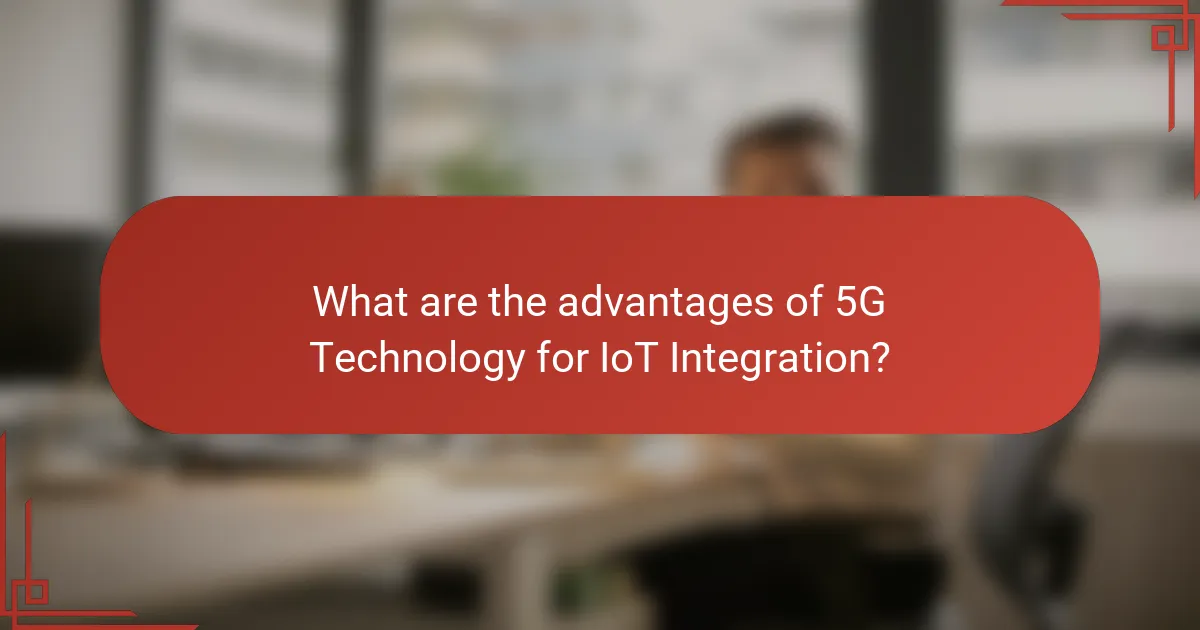
What are the advantages of 5G Technology for IoT Integration?
5G technology significantly enhances IoT integration by providing faster data transfer rates. It can achieve speeds up to 10 Gbps, enabling real-time communication between devices. This speed allows for seamless operation of smart devices in various applications. Additionally, 5G offers lower latency, with response times as quick as 1 millisecond. This rapid response is critical for applications like autonomous vehicles and remote surgeries.
Moreover, 5G technology supports a higher density of connected devices, accommodating up to 1 million devices per square kilometer. This capacity is essential for densely populated urban areas and smart city infrastructures. Furthermore, 5G networks are more energy-efficient, which prolongs the battery life of IoT devices. This efficiency is crucial for devices that require long-term deployment without frequent maintenance.
Lastly, 5G technology enhances security features, providing robust encryption and authentication methods. This security is vital for protecting sensitive data transmitted between IoT devices. Overall, the advantages of 5G technology for IoT integration include high speed, low latency, increased device capacity, energy efficiency, and improved security.
How does 5G Technology improve IoT device communication?
5G technology significantly improves IoT device communication by providing higher data transfer speeds and lower latency. This enhancement allows IoT devices to transmit and receive information more quickly. For instance, 5G can achieve speeds up to 10 Gbps, compared to 4G’s maximum of 1 Gbps. The reduced latency, which can be as low as 1 millisecond, facilitates real-time communication between devices. This is critical for applications like autonomous vehicles and smart healthcare systems. Additionally, 5G can support a larger number of connected devices simultaneously, estimated at up to 1 million devices per square kilometer. This capacity is essential for densely populated smart cities where numerous IoT devices operate concurrently. Overall, 5G technology enables faster, more reliable, and scalable communication for IoT devices, enhancing their functionality and efficiency.
What are the latency benefits of 5G for IoT?
5G technology significantly reduces latency for IoT applications. It offers latency as low as 1 millisecond. This is a dramatic improvement compared to 4G, which typically has latencies around 30 to 50 milliseconds.
Low latency allows for real-time data processing. This is crucial for applications like autonomous vehicles and remote surgery. The enhanced responsiveness improves the performance of smart city infrastructure.
Research by the International Telecommunication Union highlights these benefits. They indicate that 5G can support massive IoT deployments effectively. This capability is essential for the seamless integration of smart devices in urban environments.
How does 5G increase the number of connected devices?
5G increases the number of connected devices by offering significantly higher bandwidth and lower latency. This technology can support up to one million devices per square kilometer. The increased capacity allows for more devices to connect simultaneously without degradation in performance. 5G networks utilize advanced technologies like Massive MIMO and beamforming. These technologies enhance signal strength and reduce interference. As a result, more IoT devices can operate efficiently in dense urban environments. Moreover, 5G facilitates real-time data processing, enabling devices to communicate instantly. This capability is crucial for applications in smart cities and IoT ecosystems.
What are the security advantages of 5G for IoT?
5G technology enhances security for IoT devices through improved encryption and authentication methods. It employs advanced encryption standards that protect data during transmission. This reduces the risk of data breaches and unauthorized access. Additionally, 5G networks support more robust authentication protocols. These protocols ensure that only authorized devices can connect to the network.
The network slicing feature of 5G allows for the creation of isolated virtual networks. This isolation minimizes the risk of attacks spreading across devices. Furthermore, 5G’s low latency enables real-time security monitoring and response. This enhances the ability to detect and mitigate threats quickly.
According to research by the GSMA, 5G networks are designed with security as a foundational element. The architecture includes built-in security features that are more advanced than previous generations. This makes 5G a significant upgrade for securing IoT ecosystems.
How does 5G Technology enhance data protection for IoT?
5G technology enhances data protection for IoT through advanced encryption methods. It uses stronger encryption protocols compared to previous generations. This ensures that data transmitted between devices is secure from unauthorized access. Additionally, 5G supports network slicing, which allows for the creation of isolated virtual networks. This isolation reduces the risk of data breaches across different IoT applications. Furthermore, 5G networks offer improved authentication mechanisms. These mechanisms verify device identities more effectively, reducing the chances of spoofing attacks. According to the GSMA, 5G networks are designed to be more resilient against cyber threats. This makes them suitable for critical IoT applications in smart cities. Overall, 5G technology provides a robust framework for securing IoT data.
What security protocols are integrated within 5G?
5G integrates several security protocols to enhance network protection. These include Authentication and Key Agreement (AKA) protocols for user identity verification. Additionally, 5G employs enhanced encryption methods to secure data transmission. The integrity of the signaling is protected through the use of integrity protection protocols. Network slicing introduces unique security measures for different services. Moreover, 5G introduces a new security architecture that improves threat detection. These protocols collectively address vulnerabilities present in previous generations. The 3rd Generation Partnership Project (3GPP) outlines these security frameworks in its technical specifications.
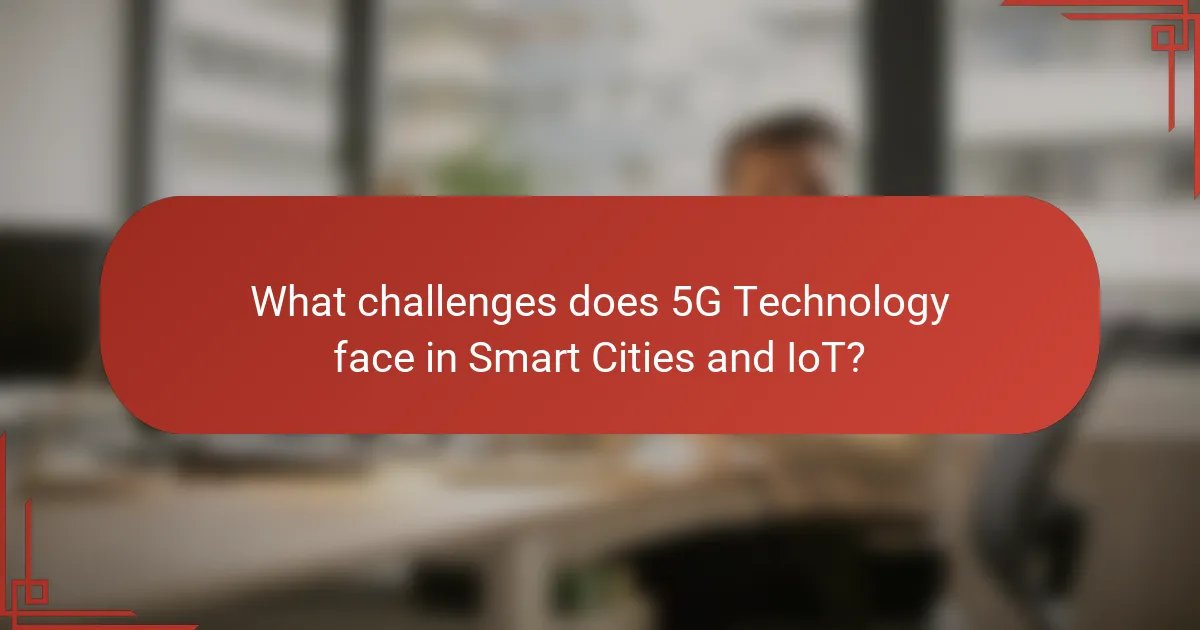
What challenges does 5G Technology face in Smart Cities and IoT?
5G technology faces several challenges in smart cities and IoT. One primary challenge is infrastructure development. Upgrading existing networks to support 5G requires substantial investment and time. Another challenge is spectrum allocation. Limited availability of radio frequencies can hinder effective deployment. Additionally, security concerns are significant. The increased connectivity makes smart cities vulnerable to cyberattacks. Interoperability issues also arise. Different devices and systems may not seamlessly communicate with each other. Lastly, regulatory hurdles can delay implementation. Compliance with various regulations complicates the rollout of 5G technology. These challenges must be addressed to fully realize the potential of 5G in smart cities and IoT.
What are the infrastructure requirements for 5G deployment?
5G deployment requires a dense network of small cells, high-capacity backhaul, and fiber optic cables. Small cells are crucial for providing coverage and capacity in urban areas. These cells are typically placed on streetlights, buildings, and utility poles. High-capacity backhaul connects these small cells to the core network. Fiber optic cables are essential for transmitting large amounts of data quickly and efficiently. Additionally, advanced antennas and radio equipment are necessary for enabling higher frequency bands used in 5G. Network slicing technology allows for customized services over the same infrastructure. These requirements ensure that 5G can deliver faster speeds and lower latency compared to previous generations.
How does the cost of 5G implementation affect Smart Cities?
The cost of 5G implementation significantly impacts Smart Cities by influencing infrastructure investment and operational budgets. High initial costs can limit the speed and scale of deployment. Cities may face budget constraints that prioritize other essential services over 5G infrastructure. This can delay the integration of smart technologies that rely on 5G connectivity. According to a report by the International Telecommunication Union, cities investing in 5G can expect a return on investment through improved efficiency and economic growth. However, without adequate funding, potential benefits may remain unrealized.
What are the regulatory challenges associated with 5G?
Regulatory challenges associated with 5G include spectrum allocation, infrastructure deployment, and compliance with safety standards. Spectrum allocation involves the efficient management of radio frequencies to avoid interference. Different countries have varying regulations for spectrum usage, complicating international deployment. Infrastructure deployment faces hurdles such as zoning laws and local government approvals. These regulations can delay the installation of necessary equipment. Compliance with safety standards is critical to ensure public health and safety. Regulatory bodies must assess the potential health impacts of increased radio frequency exposure. Additionally, cybersecurity regulations are essential to protect data transmitted over 5G networks. Overall, navigating these regulatory challenges is crucial for the successful rollout of 5G technology.
How can cities overcome barriers to 5G adoption?
Cities can overcome barriers to 5G adoption by implementing strategic policies and fostering collaboration. Establishing clear regulatory frameworks can streamline the deployment process. Cities should prioritize public-private partnerships to leverage resources and expertise. Investing in infrastructure upgrades is essential for supporting 5G technology. Educating the public about the benefits of 5G can help alleviate concerns. Addressing issues related to funding can facilitate smoother implementation. Additionally, cities can engage with stakeholders to ensure community needs are met. Research indicates that cities with proactive strategies see faster 5G rollouts and increased user adoption.
What strategies can be employed to facilitate 5G integration?
To facilitate 5G integration, several strategies can be employed. First, infrastructure investment is crucial. Upgrading existing cellular towers and building new ones enhances coverage. Next, collaboration among stakeholders is essential. Telecom companies, governments, and technology providers must work together. Implementing network slicing allows for tailored connectivity solutions. This flexibility supports various applications, from IoT devices to smart city services. Additionally, regulatory frameworks should be streamlined. Clear guidelines accelerate deployment and reduce bureaucratic hurdles. Finally, public awareness campaigns can educate users on benefits. This fosters acceptance and encourages adoption of 5G technologies.
What best practices should be followed for effective 5G integration?
Effective 5G integration requires strategic planning and execution. First, organizations should conduct a thorough assessment of existing infrastructure. This helps identify compatibility and upgrade needs. Second, collaboration with telecom providers is essential. Partnerships ensure access to the latest technology and support. Third, implementing robust cybersecurity measures is critical. These protect data integrity and user privacy in 5G networks. Fourth, investing in training for personnel enhances operational efficiency. Skilled staff can better manage and troubleshoot 5G systems. Fifth, continuous monitoring and optimization of network performance are necessary. This ensures the network meets evolving demands. Lastly, engaging with stakeholders fosters community support and addresses concerns. These best practices facilitate a smooth transition to 5G, enhancing smart city and IoT integration.
5G technology is the fifth generation of mobile network technology, offering faster data speeds, lower latency, and increased capacity, making it essential for smart cities and IoT integration. With capabilities of up to 10 Gbps and support for over 1 million devices per square kilometer, 5G enhances connectivity and enables real-time communication for applications such as autonomous vehicles and smart infrastructure. The article explores how 5G supports urban development, improves public services, and addresses challenges related to implementation, security, and regulatory compliance, while highlighting best practices for effective integration in smart city frameworks.
